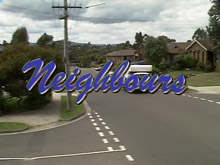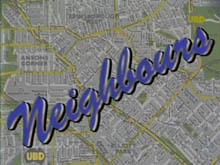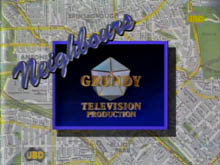|
.

Comment
> Eras of Erinsborough: Part One
by Steve
The first seven years of Neighbours saw it all begin, then rise to become a TV phenomenon in both the UK and Australia. Here’s a look back at the period from 1985 to 1992, which witnessed some of the series’ most memorable storylines and characters, as well as seeing the show axed, change channels and become a worldwide hit.
|

|
The Neighbours of 1985 wasn’t quite what we’re used to in 2005. With a much smaller cast and less concentration on the younger characters, the show had a slightly more adult feel to it. The one thing that has been a constant, however, is the comedy. From the very beginning, characters like Max Ramsay and Des Clarke provided much of the comic relief, while, in the first episode, a drunk Paul Robinson in a nappy was delivered home to his father. The storytelling style was also quite different to what we’ve come to expect. Although there were a few long-running dramas – including the revelation that Danny wasn’t Max’s son and the on-off relationship of Des Clarke and Daphne Lawrence – many stories were played out in a single week. Guest characters would appear for very short periods of time and disappear once their story had been told. As the year continued, however, a lot of the comedy fell by the wayside, as the character of Terry Inglis and her dodgy underworld connections appeared to take over a lot of the action. Two major 1985 storylines saw Terry having to escape from a dangerous old flame, with the second of these ending in murder. It was around this time that the series drew to a close – seemingly forever.
When Neighbours moved from Channel Seven to Ten in early 1986, having been rescued from the axe, it seemed like a lot of work had gone into bringing back the comedy element that went missing the year before. Young, zany characters like Clive Gibbons and Zoe David were a breath of fresh air, while the introduction of Madge Mitchell, giving Max a sister to bicker with, was a stroke of genius. The return of interfering Eileen Clarke, mother to Des, and the arrival of queen of the battleaxes, Nell Mangel, cemented the strong, new cast. The stories told by the neighbours became more open-ended, lasting for weeks and months and each family was given a stronger back story and a series of supporting characters. The suburb was finally given a name – Erinsborough. The locations extended beyond the end of Ramsay Street – to a local hotel named Lassiter’s, where eventually Daphne’s Coffee Shop and the offices of the Daniels Corporation also moved.
|

|
Neighbours was a much stronger show after its move to Network Ten, but it was the introduction of some younger characters that really proved to be a turning point. At the beginning of the year, the character of Scott Robinson was recast with Jason Donovan and he found himself a new friend, Coffee Shop employee Mike Young. Completing the group of youngsters was Helen Daniels’ niece, Nikki Dennison and a few weeks later, Madge’s tearaway daughter, Charlene. The couplings of Scott and Charlene, and Mike and Nikki proved to be extremely popular, and the interest only increased when, midway through the year, Nikki was replaced with Mrs Mangel’s shy granddaughter, Jane Harris. Jane's transformation from quiet nerd to confident young woman proved to be more captivating than Nikki's snobby attitude and soon the four youngsters were attracting a lot of the attention that the series received.
Although some of the new characters – Zoe, Nikki, Tom – didn’t last long, the show had a new energy which saw it through to another season. 1987 was the year that Neighbours really saw its popularity sore, with Scott and Charlene becoming one of the biggest soap couples the world had ever seen, and their portrayers, Jason Donovan and Kylie Minogue, found international fame. The event that brought the show its peak success was their wedding, broadcast in Australia on July 1st 1987. Although the cast saw several changes that year, the new characters proved to be just as popular as the ones that they replaced, particularly one Harold Bishop, who was brought in to give Madge a love interest. Indeed, Harold and Madge’s popularity even saw them release a record together and the couple remained a part of the show until 2001, albeit with a break between 1991 and 1996.
|

|
The days when the show was massively popular were over, but it was still doing well. Mrs Mangel left Australia, but was replaced with her son, Joe. Joe couldn’t have been more different to his mother, but the character proved to be just as popular. The role of battleaxe was filled by Edith Chubb and later Hilary Robinson, while Scott and Charlene grew up and moved on. Their successors, Nick and Sharon, then Todd and Cody, were never as massively popular, but kept the teenage viewers interested with their antics. The comedy, coupled with a regular stream of teenagers for Madge, Harold, Jim and Helen to look after, served the series well for several years. But as Neighbours moved into the 90s, the tiredness began to show a little. In the face of strong competition from the likes of Home and Away and E Street, things in Ramsay Street would need to change.
1991 gave Neighbours plenty to think about. The only original characters left in the series were Jim Robinson, his mother-in-law Helen, his eldest son Paul and youngest child, Lucy, who was being portrayed by the third actress in the role, Melissa Bell. The loss of Harold, Joe and Melanie – three of the show’s strongest comedic characters – left things a little bit flat. Paul was onto his third marriage and a new family, the Willises, had taken the place of the Clarkes at number 28. Stories even included incest and euthanasia, long before the days when other soaps saw them as controversial new territory, but it didn’t look like it was enough for them to lose the 80s tag.
The show was beginning to get itself an old-fashioned reputation and so, in the middle of 1992, it was decided that Neighbours would receive a massive overhaul in presentation…
To read part two, click here...
Back |

